Feasibility Report of a Deep Geothermal Single Well, Aberdeen Exhibition and Conference Centre
Report of study which examined the technical, logistical, contractual and economic feasibility of installing a deep geothermal single well system at the new site of the Aberdeen Exhibition and Conference Centre.
Outline Well Design
The DGSW technology consists of a single, vertical well drilled to a nominal depth of 2km. The actual depth of the well is determined by the required delivery temperature to the building or plant and the natural temperature gradient at the site. In most locations in the United Kingdom, the temperature at a depth of 2km is sufficient to provide a delivery temperature adequate for space heating purposes. The well is steel cased (using standard oil and gas casing diameters) to within 300m of the base of the well. The remainder of the well is either open hole (i.e. exposed to the surrounding rock) or cased with perforated casing. The well at AECC will be open hole at the base due to the anticipated competency of the granite. A polypropylene pipe is then installed to within 50m of the bottom of the well and a submersible pump installed to a depth of circa 200m within the polypropylene pipe. Water is drawn up through the pipe that also acts as an insulator. This heated water is then passed through a heat exchanger, the thermal energy removed, and the cooler water rejected back to the top of the well. As the depth of the well governs the delivery temperature (and is well constrained), the system can be designed to suit the flow and return temperature of the building. Depending on the type of end use, delivery temperatures will be between 45 and 75°C. A low temperature requirement is cheaper to deliver as the well can be drilled to a shallower depth. A schematic design of the system is shown in Figure 8.
The DGSW has been designed to use off-the-shelf materials and to be easy to install (install time of two weeks post-drilling) and maintain. The design has been extensively modelled, both analytically and numerically as part of a previous DECC funded project. The results show that the system can achieve peak thermal delivery rates of between 400 and 600kW and supply between 2 and 3.5GWh of heat per year depending on the building utlisation rate. The system has also been field testing in an existing well in 2014 as part of a previous DECC funded project. The trial showed that for every one unit of electricity used by the pump, between 40 and 50 units of thermal energy can be delivered at the surface.
The level of modelling and testing performed on the DGSW is considered to place the system at a technology readiness level (TRL) of TRL 6 where a "system has been installed and tested in a relevant environment". Through developing the technology to this level, the DGSW system is at the point where it can be incorporated into a commercial project.
The well construction and drilling methodology used by Geothermal Engineering Ltd has been approved by the on shore Health and Safety Executive for a recent project at the Crewe Campus of the Manchester Metropolitan University. The design and methodology was also approved by the Environment Agency in England who gave permission to drill a proposed 2km vertical well at the Crewe Campus. This design would be very similar to that proposed at the AECC site.
The major components of the system are:
| Component | Purpose |
|---|---|
| Polypropylene Pipe | Insulate the hot water as it is drawn from the bottom of the well to the surface |
| Submersible Pump | Draw water from the bottom of the well to the top |
| Flexible Riser | Transport water from the submersible pump to the surface |
| Thermistor string | Monitor temperature in the well during operation |
| Surface pipework | Connections between the well and the plant room |
| Steel weights | Fitted to the polypropylene pipe to avoid negative buoyancy |
| Cable ties and sundries | Attach the thermistor string to the polypropylene pipe |
| Connection pipework | Pipework interface at the wellhead |
| Bleed valve and isolation valves | Bleed flow control during peak delivery periods |
| Temp and flow sensors/ meters | Monitoring equipment to calculate heat delivery |
| Pump control system | Control apparatus for the submersible pump |
| Insulation | Pipework insulation in the plant room |
| Fittings | Pipework connections within the plant room |
| Heat exchanger | Point of delivery of heat from the DGSW to the existing network |
| Filtration unit | Cyclonic filter to remove any particulates prior to the DGSW water entering the heat exchanger |
Figure 8: Schematic of the proposed well for the AECC site
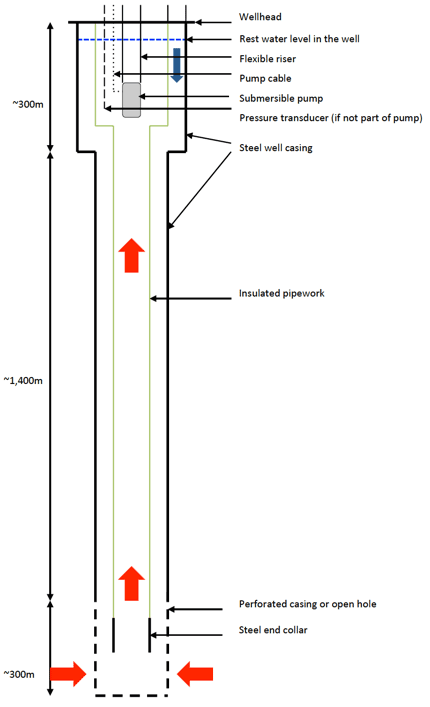
Operational Modes
- The system has been designed to operate in two principal modes (Figure 9):
- Monovalent System - DGSW sole source of heat Bivalent System - DGSW using gas fired boilers for Supplementary Heat
Figure 9: DGSW in monovalent and bivalent mode
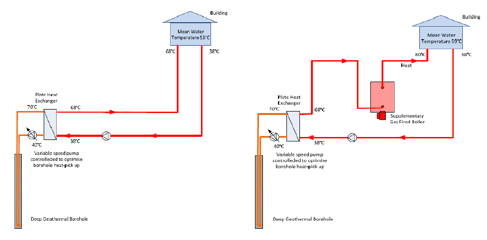
In a standard heat supply project, to maximise the thermal output of the DGSW, the operation of existing heating systems will be adapted to run on a lower mean water temperature (MWT) than the norm (Figure 9). The MWT is very well suited to modern buildings that deploy underfloor heating or warm air systems. For retrofits, the secondary circuits will be configured to deliver space heating for longer time periods to accommodate the lower MWT. Thermal storage will also be added to the system (if not already in place) to provide better regulation of the delivery temperature.
In monovalent form, the system provides a simple robust solution to the delivery of heat with very low carbon content to buildings with underfloor heating or lower temperature distribution systems. We would expect to deploy the monovalent system in all new builds. The bivalent system is likely to be the form most commonly implemented in early stage retrofit projects.
Operation
The operation of the system is managed through the control of the submersible pump flow rate and the bleed valve (Figure 10). The DGSW reaches peak delivery temperatures after approximately 35 minutes of operation and therefore the submersible pump control will be linked into the Building Management System (BMS) to trigger the pump to start prior to the heating being required in the buildings. For the AD unit at the AECC, the system will have little downtime and therefore, once operational, will continue to pump at a fixed flow rate determined by the AD heat demand. Depending on the seasonal requirements of the residential units, the flow rate may be increased in the winter periods. This will be determined once the well has been drilled and tested with the Thermal Response Test unit that was designed and constructed by GEL.
Maintenance
The primary circuit (the DGSW system) will be circulating groundwater that may contain some dissolved solids, although the majority will remain at the bottom of the well. A cyclonic filtration unit will be installed on the primary circuit to prevent any remaining solids from passing through the heat exchanger (Figure 10).
The maintenance schedule will consist of monthly inspections of the filtration unit to ensure that there is no build up of sediments in the system. At the same time, water quality samples will be taken. During the monthly inspection, all aspects of the system will be checked for signs of deterioration or unexpected problems. On a yearly basis, the heat exchanger will be inspected and, if required, treated and cleaned. At the same time, the submersible pump will be removed from the well, inspected and cleaned if required. The pump removal and inspection will mean that the system is off-line for 6 hours.
Interface with Anaerobic Digestion Unit
The interface with the AD unit will be in the existing plant room and will consist of a 500kW heat exchanger with associated flow and return pipework. On one side of the heat exchanger is the fluid from the well, on the other, the fluid circulating within the AD unit. A schematic for a typical DGSW plant room is shown in Figure 10.
Figure 10: Plant room items and connection to the AD building
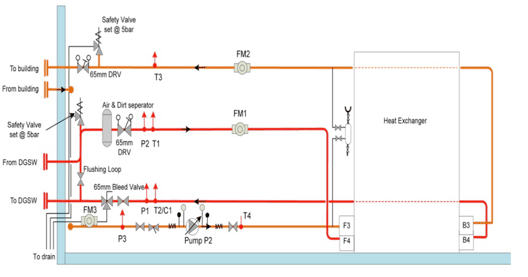
Soft Start and Soft Stop
The pump will be fitted with an inverter to achieve variable speed control. The pump will be soft-started with the speed ramped up over 2 minutes to overcome the inertia of the primary circuit water content and to establish sufficient motor cooling. This will avoid a low-pressure trip. Likewise, on shut down of the primary pump, a 'soft-stop' will be used to dissipate the momentum of the borehole circuit, ramping the pump speed down over 2 minutes.
Integration and Optimisation of DGSW
The AECC site will showcase multiple renewable energy sources to supply the site with both heat and electricity. These sources will include an Anaerobic Digestion plant with a required heat input load of between 400 and 500kW> for 24 hrs of the day, 365 days of the year. This heat load is particularly well suited to the delivery capacity of the deep geothermal single well. The AD plant is conceived as a gas to grid facility although there will also be a private pipe to provide a biomethane feed to the on-site CHP housed in the energy centre building. Whilst AD technology is well established in the UK at farm scale (operating on energy crops and farm residues) and as merchant bio-waste disposal facilities, there is less experience of operating AD plants as part of an integrated CHP facility. This is a particularly ambitious project integrating off-site fuel preparation and storage and on-site deep geothermal hot water supplies. The AD plant will comprise of an on-site component that includes: the reception building, the main AD digester and storage, gas-upgrade equipment and the gas injection point. At this stage it is anticipated that the AD facility will be a composite wet and dry AD plant (Figure 14). It is proposed that the plant will be sized to produce a biomethane stream for injection of just less than 40,000MWhrs annually together with a separate (unpropanated) bio-methane supply to the energy Centre of 16,500MWhrs. The planned annual output of the AD facility is 56,500MWhrs of biomethane.
The plant will be a co-digestion facility with agricultural and food waste substrates. The small dry digestion facility will be designed to take Aberdeen City garden waste collections (approx. 8500tpa) whilst the wet digestion will be fuelled with purchased agricultural crops and Aberdeen City food waste collections. Food waste collections are currently around 3500 tpa but these are expected to rise as the City undertakes nondomestic food waste collection services.
The usual approach for meeting the onsite energy demand for a biogas injection plant is to bleed off some of the generated biogas (before up grade) and run an onsite CHP unit to supply the parasitic loads. The intention is to replace this with the primary delivery from the DGSW (Figure 14).
Without the deep geothermal well the plant used will be:
- 500kWe CHP Unit (400kWth) high grade heat
- 600kWhth Biogas boiler
To fuel these units the generated biogas used will be approximately 1.7 million kWhrs. For the proposed AD plant the average parasitic electrical and thermal loads will be:
- Heat demand for the Wet AD tanks: approx. 200kW
- Heat demand for the Dry AD digesters: approx. 40kW
- Gas Upgrade (800kWth, 165kWe)
- AD plant 200kWe
- Pasteurisation Plant at 60C
If we assume that the DGSW is used to supply the low-grade heat then the 500kWe CHP unit can be eliminated saving approximately £500,000 of capital. A biogas boiler will still be required, however the operational savings could equate to around 1.9million kWhrs of biogas. If the gas is injected then the operational savings may be valued at (assuming 20% derogation on biomethane injection (4.5p RHI + 2.5p kWhr retail)) approximately £140,000 per annum.
The level of heat demand from the AD unit coupled to the capital and annual savings mean that this combination is a good match for the site and may be suitable to similar types of development in the future. Further, the storage and delivery yard of the proposed AD unit has very good vehicular access for both drilling the well and for maintenance access during the lifetime operation (Figure 11). It is considered that this could be a unique demonstration of renewable technology providing direct heating to another renewable technology and could potentially be marketed as an alternative to CHP units that would be used to provide heat for the AD process. This demonstrates the versatility and commercial opportunity of the DGSW and its applicability to a wide range of heat end users.
It can also be seen from Figures 11 and 12 that there are a number of residential dwellings that are in close proximity to the AD unit. These units afford an excellent opportunity to use the return flow heat from the well to supply residential heat via a small scale heat network using high temperature Ground Source Heat Pumps in each dwelling to boost the delivery temperature (Figure 13). This combination of uses maximises the thermal output from the well and is a solution that we would look to employ on future projects. We also consider that this offers a major local community benefit to local people in close proximity to the site who could benefit from receiving sustainable low carbon geothermal heating. Therefore, there is the opportunity to showcase the provision of deep geothermal heat to two end users (commercial and domestic) from one DGSW. The opportunity to showcase two end-users for the DGSW heat means that the system can be successfully demonstrated to the widest possible number of potential investors.
Figure 11: Proposed location of the single well and associated pipework to supply heat to the AD unit and residential dwellings
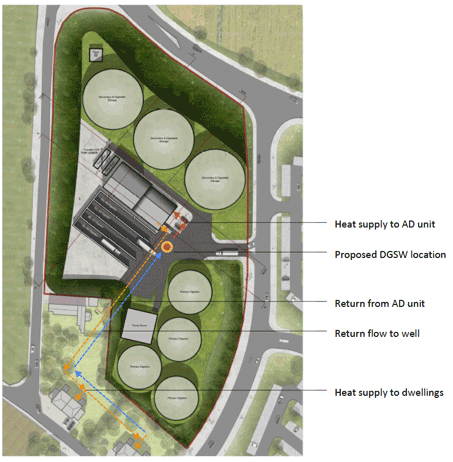
Figure 12: Location of AD unit, well and residential dwellings
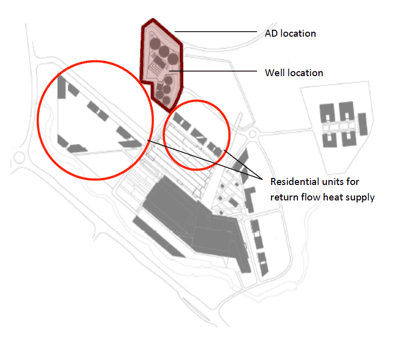
Figure 13: Schematic of the DGSW network
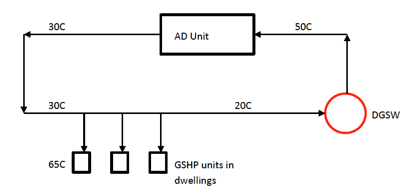
Figure 14: Schematic diagram showing the integration of the geothermal well into the AD unit
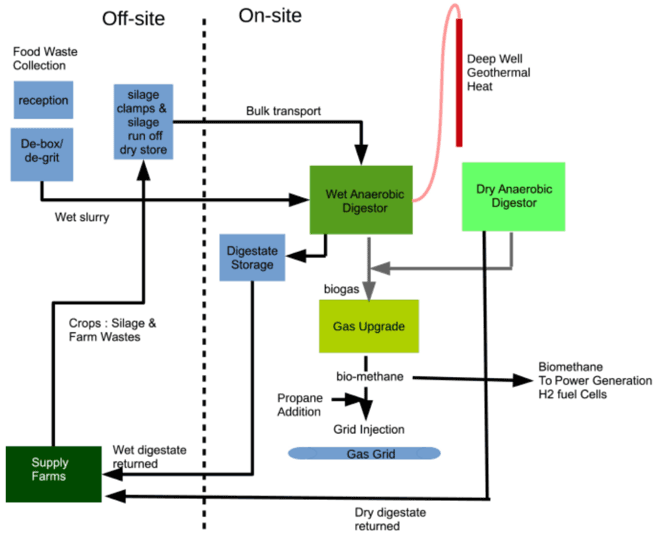
Contact
Email: Johann MacDougall
There is a problem
Thanks for your feedback